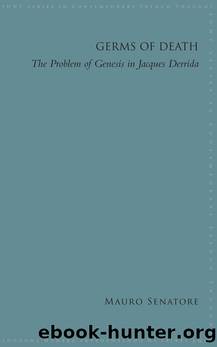Germs of Death by Senatore Mauro

Author:Senatore, Mauro [Senatore, Mauro]
Language: eng
Format: epub
ISBN: 9781438468495
Publisher: SUNY Press
Published: 2018-07-15T05:00:00+00:00
THE SYSTEMATIC FIGURE OF THE GERM
Derrida focuses on the natural image of the germ as it is conjured up in the account of âthe determinations of the spiritâ in Reason in History. Hegel explains that the essence of the spirit is activity, which consists in the self-equality of spiritual lifeâthat is, in the spiritâs reproducing itself, in its being at once the beginning and the end of this act of reproduction, father and son and, thus, family. This activity is not natural and is finite only in a restricted sense (namely, in man), just as the father-son relation and family are. Hegel writes:
When the spirit strives (strebt) towards its own center, it strives to perfect (vervollkommnen) its own freedom; and this striving is fundamental to its nature. To say that spirit exists would at first seem to imply that it is a completed entity (etwas Fertiges). On the contrary, it is by nature active (Tätiges), and activity; it is its own product (Produkt), and is therefore its own beginning and its own end. Its freedom does not consist in static being (ruhende Sein), but in a constant negation of all that threatens to destroy freedom. The activity of spirit is to produce itself, to make itself its own object and to gain knowledge of itself; in this way it exists for itself. Natural things do not exist for themselves: for this reason, they are not free. (Derrida 1986, 24)6
Spiritual activity starts with the becoming-life of matter. Within this movement, the shift from the animal to human marks the transition from the animal moment of life to the spiritual one. To schematize this process, Hegel ascribes this transition to the fact that man inhibits the animal pressure (Trieb / poussée) by idealizing and interposing the ideal between pressure and satisfaction. He explains that âsince he [man] knows the real (Realen) as the ideal (Ideellen) ⦠this knowledge leads him to suppress (hemmt) his pressures; he places the ideal, the realm of thought, between the demands (Drangen) of the pressure and their satisfactionâ (26).7 Therefore, he concludes, by interrupting the animal auto-mobility in himself man breaks with natural life and frees freedom (what Derrida calls âthe self-mobility of the spirit,â 27).
At this point, Hegel retrieves the figure of the germ in order to account for the transition from natural to spiritual life and thus for the liberation of spiritual activity. As anticipated, Derrida observes that this figure is remarked throughout the regions of the system and that it relates one region to another on the basis of the analogy between nature and spirit (or, as Derrida calls it, speculative dialectics). He explains:
The germ (der Same) is also, as germ, the onto-theological figure of the family. This concept (of) germ (Same, semen, seed, sperm, grain) regularly enters on the scene in speculative dialectics, in places and regions of the encyclopedic discourse that are not at once homologous and distinct [my emphasis], whether of the vegetal, biological, anthropological, or the onto-logical order in general. Among all these orders, speculative dialectics assures a system of figurative correspondences.
Download
This site does not store any files on its server. We only index and link to content provided by other sites. Please contact the content providers to delete copyright contents if any and email us, we'll remove relevant links or contents immediately.
The Art of Coaching by Elena Aguilar(50011)
Thinking, Fast and Slow by Kahneman Daniel(10578)
The Art of Thinking Clearly by Rolf Dobelli(8841)
The 5 Love Languages: The Secret to Love That Lasts by Gary Chapman(8493)
Mindhunter: Inside the FBI's Elite Serial Crime Unit by John E. Douglas & Mark Olshaker(7833)
Therapeutic Modalities for Musculoskeletal Injuries, 4E by Craig R. Denegar & Ethan Saliba & Susan Saliba(7348)
Periodization Training for Sports by Tudor Bompa(7327)
When Breath Becomes Air by Paul Kalanithi(7261)
Bodyweight Strength Training by Jay Cardiello(7184)
Becoming Supernatural by Dr. Joe Dispenza(7103)
Turbulence by E. J. Noyes(7037)
Nudge - Improving Decisions about Health, Wealth, and Happiness by Thaler Sunstein(6633)
The Road Less Traveled by M. Scott Peck(6633)
Enlightenment Now: The Case for Reason, Science, Humanism, and Progress by Steven Pinker(6405)
Win Bigly by Scott Adams(6310)
Mastermind: How to Think Like Sherlock Holmes by Maria Konnikova(6234)
Kaplan MCAT General Chemistry Review by Kaplan(6053)
The Way of Zen by Alan W. Watts(5798)
Why We Sleep: Unlocking the Power of Sleep and Dreams by Matthew Walker(5639)
